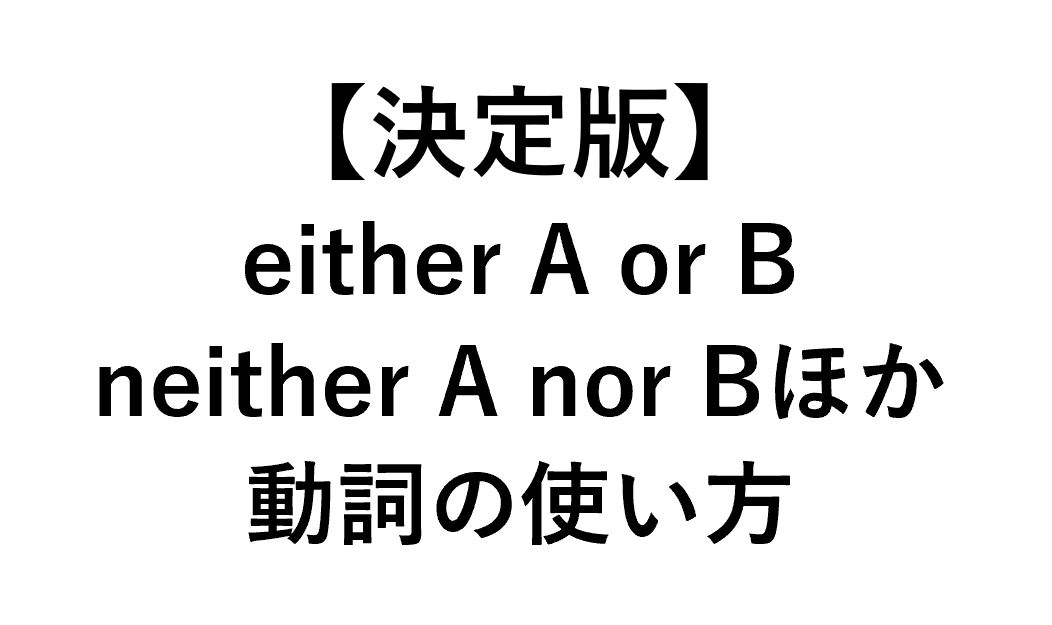今回はeither A or B / neither A nor B / not A but B / not only A but also B / B as well as A / both A and Bの意味や、主語に来た時の動詞の形についてまとめたいと思います。
大学入試のほか、TOEICでも頻出の事項なので押さえておきたいところです。
一見数は多いですが、原則さえ押さえてしまえば、一気に理解できますよ!
例文付きで見ていきましょう!
【意味/動詞の形まとめ】either A or B/neither A nor B/not A but B/not only A but also B/B as well as A/both A and B
まずはまとめからです。主語に来た時の動詞の形は、下記のとおりです。
<動詞がBに一致>
- either A or B: AかBどちらか
- neither A nor B: AもBもどちらも~ない
- not A but B: AではなくB
- not only A but (also) B: AだけではなくBもまた (butやalsoは省略可)
=B as well as A: A同様Bもまた(意味の中心がBにあるため)
- both A and B: AとB両方

数が多い…
押さえるポイントは、下記の二つです。
- 近い方 (B)に動詞を一致させるのが原則
- 上記の原則に当てはまらないときは、意味内容に動詞を一致させる

わかったような、わからないような…
例文付きで一つずつ見ていきましょう!
either A or B/neither A nor B/not A but B/not only A but also B/B as well as A/both A and Bの例文
こちらが例文です。それぞれ解説付きで紹介します。
either A or B / neither A nor B / not A but B / not only A but also B
まずはeither A or B / neither A nor B / not A but B / not only A but also Bです。
全て、近い方 (B)に動詞の形を一致させましょう。
- either A or B: AかBどちらか
- neither A nor B: AもBもどちらも~ない
- not A but B: AではなくB
- not only A but also B: AだけではなくBもまた
例文はコチラです。
Either you or Tom is wrong.
(君かトムのどちらかが間違っている)
Either Tom or you are wrong.
(トムか君のどちらかが間違っている)
Neither you nor Tom is wrong.
(君もトムもどちらも間違っていない)
Neither Tom nor you are wrong.
(トムも君もどちらも間違っていない)
Not you but Tom is wrong.
(君ではなくトムが間違っている)
Not Tom but you are wrong.
(トムではなく君が間違っている)
Not only you but also Tom is wrong.
(君だけではなく、トムもまた間違っている)
Not only Tom but also you are wrong.
(トムだけではなく、君もまた間違っている)
動詞に近い方のBに動詞の形が一致していますね!
なお、not only A but also Bは、alsoが省略されることはもちろん、くだけた表現ではbutも省略されるので要注意です。
B as well as A
次はB as well as Aです。
Bに動詞の形は一致するのですが、AとBの位置が逆になっていることに注目してください。
- B as well as A: A同様Bもまた

どうして?
例文で考えてみましょう。
Tom as well as you is wrong.
(君同様、トムもまた間違っている)

トム…かな?
- not only A but (also) B: AだけではなくBもまた (alsoは省略可)
- B as well as A: A同様Bもまた
both A and B
- both A and B: AとB両方
Both you and Tom are wrong.
(君とトムの両方とも間違っている)
おわりに
いかがでしたか? 以上、either A or B/neither A nor B/not A but B/not only A but also B/B as well as A/both A and Bの動詞の形の一致でした。
大学入試のほか、TOEICなんかでもちょくちょく見る形ですので、覚えておくと即得点アップにつながりますね!




コメント